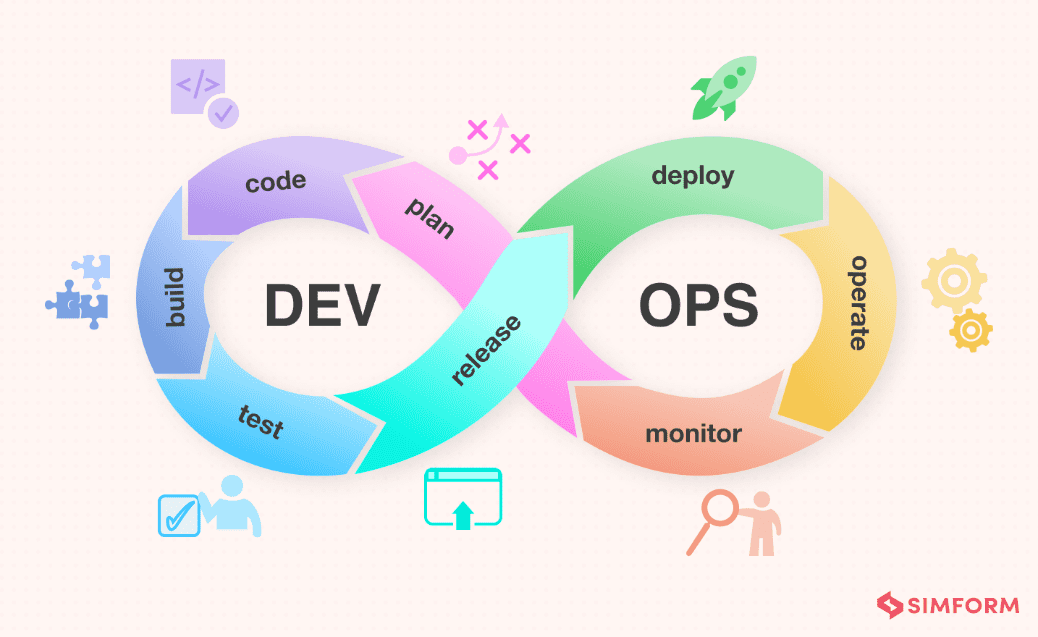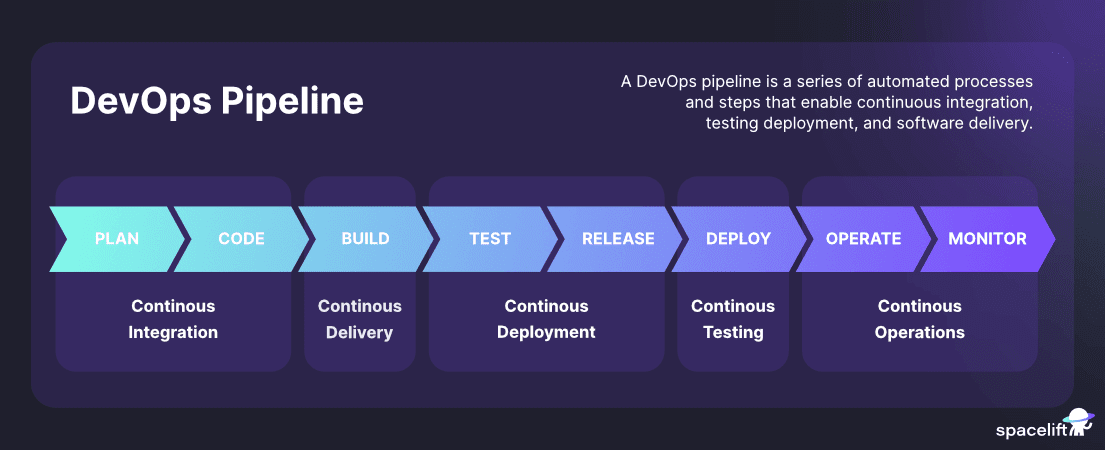The DevOps Lifecycle and DevOps Pipeline Explained
Everything you need to know
05 mins read
If you're looking for DevOps lifecycle information, this article is for you. You might also be looking for DevOps pipeline or DevOps workflow information, and depending on who's explaining DevOps to you, the terms lifecycle, pipeline, and workflow might be used interchangeably. However, the terms DevOps lifecycle and DevOps pipeline are more likely to be employed than DevOps workflow.
This article explains the term DevOps lifecycle before covering the DevOps pipeline.
The DevOps lifecycle and DevOps pipeline explained
DevOps is a framework that promotes closer collaboration between development and operations teams (as shown in the DevOps lifecycle "infinity loop" covered next) and automation across the DevOps lifecycle.
The DevOps lifecycle is a set of practices and stages that facilitate continuous integration, continuous delivery, and rapid software deployment. Where:
- Continuous integration involves regularly integrating code changes from multiple developers into a central repository, followed by automated builds and tests.
- Continuous delivery builds on continuous integration, automating the software release process so developers can reliably and efficiently deploy applications into production.
Collectively, continuous integration and continuous delivery are often denoted by the acronym CI/CD.
The term "DevOps pipeline" can refer to the set of automated processes and tools used to facilitate the continuous delivery of software. It's more of a technical and tool-driven concept than the DevOps lifecycle. So, the DevOps lifecycle has a broader scope, including the DevOps pipeline and the cultural and operational changes that DevOps brings.
The DevOps lifecycle "infinity loop"
The DevOps lifecycle "infinity loop," shown below, is used to articulate how the eight DevOps lifecycle phases flow.

The lefthand side of the DevOps infinity loop denotes the development phases, and the righthand side denotes the operations phases.
There are also variants of this DevOps lifecycle infinity loop. For example:
- It might be drawn with fewer phases
- The phases might be named or even positioned differently
- Additional phases might be included - for example, "discover" or "continuous feedback."
The DevOps lifecycle might also be depicted as a circle (rather than an infinity loop). This blog/article's DevOps lifecycle content mirrors the infinity loop shown above.
The eight phases of the DevOps lifecycle
The eight phases shown in the DevOps lifecycle infinity loop above are:
- Plan - this initial phase involves defining the goals and scope. Development and operations teams (if separate) collaborate to understand the requirements, set priorities, and plan the workflow.
- Code - developers write code to create new features, fix bugs, or enhance existing software. Version control systems like Git are employed to manage and track changes to the codebase.
- Build - the written code is compiled or transformed into executable programs. Tools such as Jenkins, Maven, or Gradle are used.
- Test - once the software is built, rigorous testing is undertaken to identify and fix defects. This could include unit testing, integration testing, system testing, and user acceptance testing. Automation testing tools such as Selenium or JUnit are used.
- Release - this is the preparation for application deployment into the production environment. It often includes final quality assurance, release planning, and scheduling.
- Deploy - the new code is moved into the production environment. Technologies such as container orchestration tools (e.g., Kubernetes) and configuration management tools (e.g., Ansible, Puppet, and Chef) are used.
- Operate - once deployed, ongoing maintenance and support is needed. For example, monitoring application performance, ensuring availability, and implementing updates or patches.
- Monitor - continuous monitoring tracks application performance, identifies issues, and gathers user feedback. Tools such as Prometheus, Nagios, or Splunk are used. The captured insights and feedback are used to make informed decisions about future improvements, and this feedback loop is key to the iterative nature of DevOps.
DevOps pipeline diagrams
As already mentioned, the term DevOps pipeline might be used interchangeably with DevOps lifecycle, or it might be used to denote a tools-based subset of the DevOps lifecycle. Hence, a DevOps pipeline diagram might include all eight phases described above but linearly (with it a workflow, not an infinity loop). It might also align to a number of "continuous" stages, as shown in the DevOps pipeline diagram below:

A real-world DevOps pipeline is likely depicted more technically, reflecting the focus on automated processes and tools, and the use of various tools means that organizations can have different DevOps pipelines.
As shown in the diagram, a DevOps pipeline will usually include the following elements:
- Continuous integration
- Continuous delivery
- Continuous deployment
- Continuous testing
- Continuous operations.
Tools are vital to the construct of a DevOps pipeline, with relevant technology types including:
- Source code management (SCM) tools - where developers can check their code into a version control system.
- Orchestration - which helps automate the DevOps workflows and processes involved in deploying, managing, and scaling applications.
- Configuration management - used to automate the configuration and management of software and systems, ensuring that systems are in a desired and predictable state.
- Containerization management - where applications are packaged and run in isolated environments called containers. This ensures consistency across multiple development, testing, and production environments.
Organizations might also create specific DevOps pipeline types designed to automate and streamline different software development and deployment aspects. These reflect the tool-focused nature of DevOps pipelines and include :
- Continuous integration pipeline - which automates the integration of code changes from multiple contributors.
- Continuous deployment pipeline - which automates the deployment of applications to the production environment.
- Continuous delivery pipeline - which is similar to continuous deployment, but the deployment to production is a manual step, i.e. the code changes are automatically prepared for release, but after the automated tests are passed, the deployment is done manually.
- Build pipeline - which compiles code, runs tests, and produces artifacts that can be deployed.
- Test automation pipeline - which runs a series of automated tests to validate code changes.
- Release pipeline - which automates the stages required to deploy a software update, including approvals, release strategy, and regulatory compliance.
So there you have it, everything you need to know about the DevOps Lifecycle and DevOps Pipeline.

